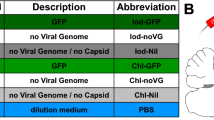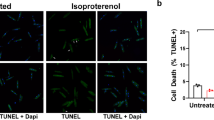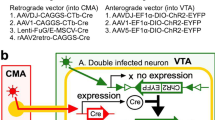Abstract
The proto-oncogene bcl-2 is known as an anti-apoptotic gene that confers the ability to block neuronal cell death after transient ischemia. In order to examine whether the bcl-2 gene can be used for protection of ischemic brain injury, we generated adeno-associated virus (AAV) vectors capable of expressing human bcl-2. Replication-defective AAV vectors were found effectively to transfer and express bcl-2 gene in the gerbil hippocampal neurons. Transduction with AAV bcl-2 5 days before forebrain ischemia prevented the DNA fragmentation in the CA1 neurons that is commonly associated with ischemia-induced cell death. Furthermore, the application of AAV bcl-2 as late as 1 h following an ischemic insult also prevented DNA fragmentation in CA1 neurons. These results suggest that the bcl-2 protein has neuroprotective functions that inhibit ischemic cell death and demonstrate the potential of AAV bcl-2 for use in post-ischemic gene therapy in the brain.
This is a preview of subscription content, access via your institution
Access options
Subscribe to this journal
Receive 12 print issues and online access
$259.00 per year
only $21.58 per issue
Buy this article
- Purchase on Springer Link
- Instant access to full article PDF
Prices may be subject to local taxes which are calculated during checkout



Similar content being viewed by others
References
Charriault-Marlangue C, Aggoun-Zouaoui D, Represa A, Ben-Ari Y . Apoptotic features of selective neuronal death in ischemia, epilepsy and gp 120 toxicity Trends Neurosci 1996 19: 109–114
Choi DW . Ischemia-induced neuronal apoptosis Curr Opin Neurobiol 1996 6: 667–672
MacManus JP, Linnik MD . Gene expression induced by cerebral ischemia: an apoptotic perspective J Cereb Blood Flow Metab 1997 17: 815–832
Lee JM, Zipfel GJ, Choi DW . The changing landscape of ischemic brain injury mechanisms Nature 1999 399: A7–A14
Kirino T . Delayed neuronal death in the gerbil hippocampus following ischemia Brain Res 1982 239: 57–69
Pulsinelli WA, Brierley JB, Plum F . Temporal profile of neuronal damage in a model of transient forebrain ischemia Ann Neurol 1982 11: 491–498
Sei Y et al. Internucleosomal DNA fragmentation in gerbil hippocampus following forebrain ischemia Neurosci Lett 1994 171: 179–182
Du C et al. Very delayed infraction after mild focal cerebral ischemia: a role for apoptosis? J Cereb Blood Flow Metab 1996 16: 195–201
Pérez-Pinzón MA et al. Cytochrome C is released from mitochondoria into the cytosol after cerebral anoxia or ischemia J Cereb Blood Flow Metab 1999 19: 39–43
Fujimura M et al. Manganese superoxide dismutase mediates the early release of mitochondrial cytochrome C and subsequent DNA fragmentation after permanent focal cerebral ischemia in mice J Neurosci 1999 19: 3414–3422
Shimazaki K, Ishida A, Kawai N . Increase in bcl-2 oncoprotein and the tolerance to ischemia-induced neuronal death in the gerbil hippocampus Neurosci Res 1994 20: 95–99
Martinou JC et al. Overexpression of Bcl-2 in transgenic mice protects neurons from naturally occurring cell death and experimental ischemia Neuron 1994 13: 1017–1030
Linnik MD, Zahos P, Geschwind MD, Federoff HJ . Expression of bcl-2 from a defective herpes simplex virus-1 vector limits neuronal death in focal cerebral ischemia Stroke 1995 26: 1670–1674
Kitagawa K et al. Amelioration of hippocampal neuronal damage after global ischemia by neuronal overexpression of BCL-2 in transgenic mice Stroke 1998 29: 2616–2621
Fan DS et al. Prevention of dopaminergic neuron death by adeno-associated virus vector-mediated GDNF gene transfer in rat mesencephalic cells in vitro Neurosci Lett 1998 248: 61–64
Fan DS et al. Behavioral recovery in 5-hydroxydopamine-lesioned rats by contransduction of striatum with tyrosine hydroxylase and aromatic L-amino acid decarboxylase genes using two separate adeno-associated virus vectors Hum Gene Ther 1998 9: 2527–2535
Ozawa K et al. Strategies for gene therapy of Parkinson's disease using adeno-associated virus (AAV) vectors Biogenic Amines 1999 15: 21–31
Kotin RM . Prospects for the use of adeno-associated virus as a vector for human gene therapy Hum Gene Ther 1994 5: 793–801
Flotte TR, Carter BJ . Adeno-associated virus vectors for gene therapy Gene Therapy 1995 2: 357–362
Kotin RM et al. Site-specific integration by adeno-associated virus Proc Natl Acad Sci USA 1990 87: 2211–2215
Samulski RJ et al. Targeted integration of adeno-associated virus (AAV) into human chromosome 19 EMBO J 1991 10: 3941–3950
Podsakoff G et al. Efficient gene transfer into nondividing cells by adeno-associated virus-based vectors J Virol 1994 68: 5656–5666
Jia WW et al. A bcl-2 expressing viral vector protects cortical neurons from excitotoxity even when administered several hours after the toxic insult Mol Brain Res 1996 42: 350–353
Lam M et al. Evidence that Bcl-2 represses apoptosis by regulating endoplasmic reticulum-associated Ca2+ fluxes Proc Natl Acad Sci USA 1994 91: 6569–6573
Murphy AN et al. Bcl-2 potentiates the maximal calcium uptake capacity of neural cell mitochondria Proc Natl Acad Sci USA 1996 93: 9893–9898
Shimazaki K et al. Reduced calcium elevation in hippocampal CA1 neurons of ischemia-tolerant gerbils NeuroReport 1998 9: 1875–1878
Susin SA et al. Molecular characterization of mitochondrial apoptosis-inducing factor Nature 1999 397: 441–446
Rosse T et al. Bcl-2 prolongs cell survival after Bax-induced release of cytochrome C Nature 1998 391: 496–499
Cho S et al. Blockade of tetrahydrobiopterin synthesis protects neurons after transient forebrain ischemia in rat: a novel role for the cofactor J Neurosci 1999 19: 878–889
Krajewski S et al. Release of caspase-9 from mitochondria during neuronal apoptosis and cerebral ischemia Proc Natl Acad Sci USA 1999 96: 5752–5757
Thilmann R, Xie Y, Kleihues P, Kiessling M . Persistent inhibition of protein synthsis precedes delayed neuronal death in postischemic gerbil hippocampus. Acta Neuropathol (Berl.) ) 1986 71: 88–93
Widmann R, Kuroiwa T, Bonnekoh P, Hossmann KA . [14C] Leucine incorporation into brain proteins in gerbils after transient ischemia: relationship to selective vulnerability of hippocampus J Neurochem 1991 56: 789–796
Chopp M, Li Y, Zhang ZG, Freytag SO . p53 expression in brain after middle cerebral artery occlusion in the rat Biochem Biophys Res Commun 1992 182: 1201–1207
Chen J et al. Expression of the apoptosis-effector gene, Bax is up-regulated in vulnerable hippocampal CA1 neurons following global ischemia J Neurochem 1996 67: 64–71
Tortosa A, Rivera R, Ferrer I . Dose-related effects of cycloheximide on delayed neuronal death in the gerbil hippocampus after bilateral transitory forebrain ischemia J Neuro Sci 1994 121: 10–17
Dunnett SB, Björklund A . Prospects for new restorative and neuroprotective treatments in Parkinson's disease Nature 1999 399: A32–A39
Matsushita T et al. Adeno-associated virus vectors can be efficiently produced without helper virus Gene Therapy 1998 5: 938–945
Gavrieli Y, Shermann Y, Ben-Sasson SA . Identification of programmed cell death in situ via specific labeling of nuclear DNA fragmentation J Cell Biol 1992 119: 493–501
Acknowledgements
pB4 was kindly supplied by Dr Y Tsujimoto, Department of Genetics, Faculty of Medicine, Osaka University. This work was supported in part by Grants in Aid from the Ministry of Education, Science and Culture of Japan (10680749); by grants from the Ministry of Health and Welfare of Japan (H10-genome-026); and from Special Coordination Funds for promoting Science and Technology of STA. We thank Ms Y Hirano and Mr T Mizui for their technical assistance.
Author information
Authors and Affiliations
Rights and permissions
About this article
Cite this article
Shimazaki, K., Urabe, M., Monahan, J. et al. Adeno-associated virus vector-mediated bcl-2 gene transfer into post-ischemic gerbil brain in vivo: prospects for gene therapy of ischemia-induced neuronal death. Gene Ther 7, 1244–1249 (2000). https://doi.org/10.1038/sj.gt.3301211
Received:
Accepted:
Published:
Issue Date:
DOI: https://doi.org/10.1038/sj.gt.3301211
Keywords
This article is cited by
-
Potential advantages of genetically modified mesenchymal stem cells in the treatment of acute and chronic liver diseases
Stem Cell Research & Therapy (2023)
-
Tapasin modification on the intracellular epitope HBcAg18–27 enhances HBV-specific CTL immune response and inhibits hepatitis B virus replication in vivo
Laboratory Investigation (2014)
-
SK2 potassium channel overexpression in basolateral amygdala reduces anxiety, stress-induced corticosterone secretion and dendritic arborization
Molecular Psychiatry (2009)
-
Inhibition of Mitochondrial Neural Cell Death Pathways by Protein Transduction of Bcl-2 Family Proteins
Journal of Bioenergetics and Biomembranes (2005)
-
Postischemic administration of Sendai virus vector carrying neurotrophic factor genes prevents delayed neuronal death in gerbils
Gene Therapy (2004)



